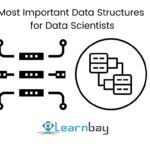 Overview of Data Structure
Overview of Data Structure
The combination of data organization, administration, retrieval, and storage into a single format that enables quick access and modification is known as a data structure. Data values, relationships between them, and pertinent activities or procedures are all gathered in this process.
Here is a specific example. To discover a book regarding military history in the 20th century, visit the library\'s History section. Then, after locating the section dedicated to military history, you would browse the volumes in chronological order until you came to the 20th century. You\'re ready to go when you think of the books as your data and the library\'s sorting system as your data structure.
What Makes Data Structure Important?
For the creation of effective algorithms, data structures are required. It offers abstraction and reusability. When executing tasks like data processing, retrieval, or storage, using the right data structures can help programmers get the job done faster. Large data sets are simpler to manipulate.
Data structures are crucial for increasing algorithm efficiency and are required to manage the enormous amounts of generated data.
Important Data Structures for Data Science and ML
- Arrays
A fixed-size structure called an array can hold items of the same data type. It may be an array of strings, an array of arrays, a floating-point value, an array of arrays, or even an array of arrays (such as 2-dimensional arrays). Random access is feasible because arrays are indexed. A detailed explanation of Data structure can be found in an online Data science course in Delhi.
- Stacks
A stack is a LIFO (Last In, First Out) structure that is frequently used in many programming languages. The element placed last can be accessed first. This construction is referred to as a "stack" because it resembles a stack of plates in the real world.
- Queues
A queue is a First In, First Out (FIFO) structure, which is frequently found in many programming languages and refers to the idea that the element placed first can be accessed first. This structure is referred to as a "queue" because it resembles a line of individuals waiting to perform an action in the real world.
- Binary Trees
A tree is a hierarchical structure in which data are arranged in levels and connected. In contrast to a linked list, which linearly links elements, this structure does not.
- Heaps
A Heap is a particular instance of a binary tree in which the values of the parent nodes are compared to those of their offspring, and the nodes are arranged accordingly.
Applied Data Structures
- Data in a computer\'s memory organization
- Information representation in databases
- Computer programmes that browse data (such as a search engine)
- Data manipulation algorithms (such as a word processor)
- Data analysis software (such as a data miner)
- Algorithms for producing data (such as a random number generator)
- Data compression and decompression techniques (such as a zip utility)
- Data encryption and decryption methods (such as a security system)
Advantages of Data Structure
- The programme is more effective when the ADT (Abstract Data Type) is chosen appropriately.
- For the creation of effective algorithms, data structures are required.
- It offers abstraction and reusability.
- Using the right data structures to perform tasks like data processing, retrieval, or storage can help programmers get the job done faster.
- Large data sets are simpler to manipulate.
Classification of Data Structures
Static data structures
Data structures known as static data structures have their size allocated at the time of compilation. As a result, the maximum size is set in stone and cannot be altered.
Dynamic data structures
Data structures known as dynamic data structures have their size allocated in real-time. As a result, the maximum size is flexible and can be altered as needed.
Hope this blog on data structures was informative and helpful. To master data structures, you need to enrol in training courses available online. You can also learn DSA and other data science techniques by joining a Data Science certification course in Delhi, co-powered by IBM.
0


